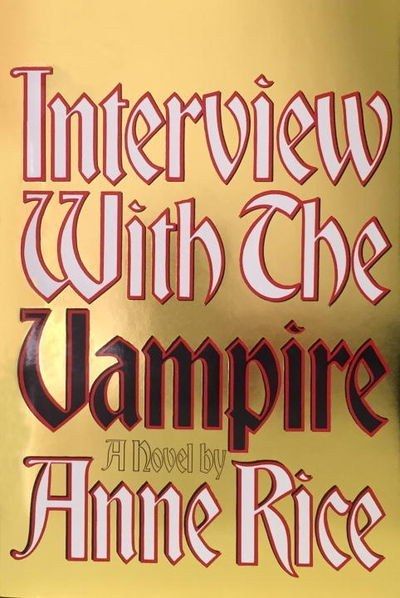Crush Of The Dark
Interview With the Vampire (Vampire Chronicles, volume 1)
By Anne Rice

22 Sep, 2024
1976’s Interview With the Vampire is the first volume of at least thirteen more books in Anne Rice’s gothic-horror Vampire Chronicles.
Armed with a tape-recorder and a stack of cassette tapes, the boy sits down with his subject, Louis. Louis is a vampire and the boy is eager to learn all the gory details.
In 1791 Louis was an unremarkable member of Louisiana’s slave-owning aristocracy. The death of his beloved brother sends Louis into a spiral of self-destructive debauchery. This, and the fact Louis owns the Pointe du Lac1 plantation, makes Louis of considerable interest to the vampire Lestat.
Louis is all too easily seduced into vampirism.
Financial acumen is not among the powers conferred by vampirism. Lestat is an ignoramus when it comes to money management. Attaching himself to canny Louis, who whatever his faults is good with managing wealth, would solve Lestat’s solvency issues. As well, Pointe du Lac’s slaves are a convenient source of victims for cruel Lestat.
This convenient arrangement has two flaws, the first of which is that despite being a slave owner, Louis has a conscience of sorts. There are limits to the abuses he will tolerate, and those limits fall short of killing people for food, let along terrorizing them as he kills them. Homicidal sadist Lestat finds Louis’ conscience bothersome.
A more pressing issue is that the slaves are not fools, nor are they content to be terrorized and eaten one by one. Lestat’s predatory ways trigger a slave uprising. The pair are lucky to escape with their … well not lives exactly… continued existence.
Being desperate to keep Louis by his side, Lestat provides Louis with a daughter of sorts, the eternal child Claudia. Poor Lestat! Claudia’s conscience proves just as problematic as Louis’. Where Louis cares too much, Claudia cares not at all. Should Lestat prove inconvenient, Claudia will not hesitate to kill Lestat.
~oOo~
Interview was tremendously popular. Whether or not this had anything to do with publisher advertising I do not know. I remember seeing TV ads for this book, at least in Canada. I do not know if the ads preceded the popularity or were an attempt to amplify the success of an already popular work. I do know that I cannot recall seeing ads for any other books in the 1970s.
Given the book’s sales record, I was surprised to discover that the sequel, The Vampire Lestat, did not appear for another nine years. Perhaps not surprising, given the genesis of Interview, written in part to deal with the grief of losing a child.
As you know, I reviewed Hôtel Transylvania last week. Was Yarbro, Hotêl’s author, inspired by Interview2? If there was any inspiration, it was negative. Hotêl’s protagonist, Saint-Germaine, is a saintly vampire who has very little in common with Louis, Lestat, or Claudia. While both novels are set partly in France, Saint-Germaine’s adventure takes place in the 1740s3, whereas Louis and company arrive in France well after the Revolution.
Yarbro and Rice’s books do share a somewhat dim presentation of queer people in that Louis and Lestat’s relationship goes well beyond the conventional comradery of two chaps who share a dining club. In Yarbo’s case, one got the impression that the author disapproved of was gay folk, whereas the issue with Louis and Lestat is that they’re horrible people who taint everything they touch.
Despite Louis’ pretension to conscience, the characters in Interview are damaged monsters. One might assume that this is due to the fact that they are vampires, but I think this would be wrong. Vampirism cannot help, but most of the characters4 in this book are messed up for reasons that have nothing to do with vampirism. They have personal reasons for being the way they are. This novel could have been entirely different if it had been set in a time when the characters could benefit from therapy… except that Claudia and Lestat would have eaten their therapists.
Characters damaged in interesting ways can make good protagonists. This, I think, is why Interview was such a hit.
How many pre-Interview books about vampires featured them as protagonists rather than monster of the week? At least one comes to mind, one with some interesting parallels with Interview. Tune in next week. You can guess which book in comments. You may also come up with more than one, which would be interesting.
Interview With The Vampire is available here (Amazon US), here (Amazon Canada), here (Amazon UK), here (Apple Books), here (Barnes & Noble), here (Chapters-Indigo), and here (Words Worth Books).
(I thought I had found a short-cut for creating the links: go to the Goodreads’ link page for Interview. It turns out that the Apple link does not resolve and the Indigo link is wrong. Is Goodreads owned by a bookseller who might not want to steer readers to other booksellers… or is this link-rot?)
1: Online sources give de Pointe du Lac as Louis’ surname, but nowhere in this novel did I see a formal surname for Louis.
2: There is, of course, a creative work I would be astounded to discover was not inspired by Interview. That work is White Wolf’s Vampire: The Masquerade, in which tragic vampires struggle tragically with the tragedy of being beautiful super-powered immortals with some minor dietary issues.
(OK, eternal beauty is not an issue for VTM’s Clan Nosferatu. Those folks have their own issues.)

3: The remarkable (although sadly vampireless) Brotherhood of the Wolf takes place twenty years later than Hôtel Transylvania and also makes a good case for the guillotine. I wonder if it’s possible to create a continuous history of France as seen through SFF novels?
4: Claudia is an exception. Because she was turned into a vampire so young, she has few human experiences on which to draw and is completely feral.
